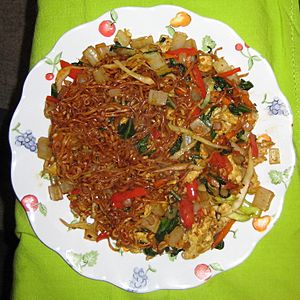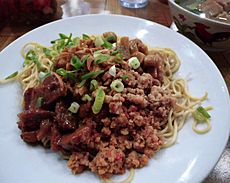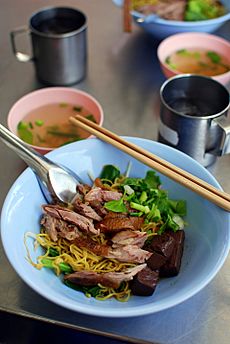Bakmi facts for kids

Bakmi topped with pork
|
|
| Alternative names | Bami, bakmie |
|---|---|
| Type | Noodle |
| Course | Main dish |
| Place of origin | China |
| Region or state | Indonesia, Thailand, Singapore, Suriname, Belgium and the Netherlands |
| Serving temperature | hot |
| Main ingredients | Wheat flour, ground pork, soy sauce |
Bakmi or bami is a super popular type of noodle that comes from China. It's made from wheat and is a big part of Chinese cooking traditions. Long ago, Chinese travelers brought these yummy noodles to places in Southeast Asia like Indonesia and Thailand.
You'll often find bakmi seasoned with soy sauce and topped with different kinds of meat. In some places, especially in Indonesia where many people are Muslim, chicken or beef is used instead of pork. These Chinese-style wheat noodles have become a favorite dish in many countries, especially where there are lots of people with Chinese backgrounds.
In Indonesia, bakmi has changed a bit to fit local tastes. It's thicker than some Chinese noodles but thinner than Japanese udon noodles. The name bakmi actually means "meat noodle." The "meat" can be chicken or beef.
Contents
What is Bakmi?
The name Bakmi comes from two Chinese words. It literally means "meat noodles." So, when you eat bakmi, you're having a delicious dish of noodles with meat!
You can see how much Chinese food has influenced dishes in Indonesia. Think about bakmi, mie ayam (chicken noodles), pangsit (dumplings), mie goreng (fried noodles), and kwetiau goreng (fried flat rice noodles). The words mie and bami even made their way into the Dutch language. This happened when the Dutch were in Indonesia a long time ago. Indonesian food is still very popular in the Netherlands, and bami goreng (fried bakmi) is a favorite there.
In Thailand, these wheat-based egg noodles are called bami. You can order them as bami nam (noodles with soup) or bami haeng (noodles without soup). They are also used in tasty Chinese-style stir-fried dishes.
Ingredients and Toppings
Bakmi or bami noodles are usually a light yellow color. The most common type in Indonesia is called mi kuning, which means 'yellow noodles'. They are made from finely ground wheat. Sometimes, eggs are added to make mi telur (egg noodles). The dough is then shaped into long noodle strings. Traditionally, people make bakmi by pulling and stretching the dough many times, just like how lamian noodles are made.
In Indonesia, the most common bakmi recipe uses chicken. This is because most Indonesians are Muslims, and they prefer chicken. Mie ayam (chicken noodle) is a popular dish where wheat noodles are topped with diced chicken seasoned in soy sauce. Mie ayam often comes with wonton (dumplings), which can be crispy fried or served in a soup. You might also get bakso (meatballs) with it. Bakmi ayam is a very common dish in Indonesian cities. You can find it everywhere, from fancy restaurants to small food carts. Another popular Indonesian bakmi dish is fried bakmi, also known as mie goreng.
How Bakmi is Made
Bakmi noodles are usually boiled before serving. If they are going to be in a soup, the noodles are often boiled separately from the broth. After boiling, the noodles are usually mixed with a little bit of animal fat, like from pork, chicken, or beef.
Then, different toppings are added. For example, you might find slices of char siu (barbecued pork), some Chinese green vegetables, and a bowl of broth on the side.
In Indonesia, the most common toppings are diced seasoned chicken with choy sum (a type of green vegetable) and crispy fried wonton skin. Some fancier versions might have fried or boiled wontons and bakso (meatballs). The soup is usually served in a separate bowl. You can add it to your noodles yourself, depending on how much soup you like.
Some famous Indonesian dishes that came from the original Chinese wheat noodle tradition include mie ayam (chicken noodle) and mie goreng (stir-fried noodles with sweet soy sauce). I fu mie is a special kind of bakmi that is first deep-fried. Then, it's topped with a thick sauce made of vegetables and meat.
Types of Bakmi
Indonesian Bakmi
- Bakmi bangka: This noodle dish comes from Bangka Island in Indonesia. It's topped with minced pork, slices of braised pork, mushrooms, and chopped green onions. If it's made for people who don't eat pork, it usually uses minced chicken instead.
- Bakmi siantar: This pork noodle dish is from Pematang Siantar in North Sumatra. It often has red char siu (roast pork) colored with angkak. It's very popular in Batak cuisine and is quite similar to the traditional Chinese Indonesian bakmi.
- Bakmi ayam: These are Indonesian Chinese chicken noodles, a very common and loved dish.
- Bakmi goreng: These are Indonesian Chinese fried noodles. You can find them everywhere in Indonesia!
- Bakmi jawa: This noodle dish comes from Central and East Java. It has a slightly wet texture.
- Bakmi aceh: From Aceh, this bakmi has a unique curry-like flavor.
- Bakmi celor: From Palembang, this one has a sweet, thick, and starchy sauce.
- Bakmi pangsit: This is well-known in the Sumatera area, especially around Medan.
- Bakmi belitung: From Belitung island, this bakmi has a sweet white sauce.
- Bakmi kangkung: This dish includes noodles, kangkung (water spinach), bean sprouts, lime juice, minced meat, and broth.
Thai Bami
- Bami haeng (บะหมี่แห้งเป็ด): This dish uses wheat noodles (bami) and is served "dry," meaning without soup.
- Bami mu daeng (บะหมี่หมูแดง): A noodle dish with delicious red roast pork.
- Khao soi (ข้าวซอย): This is a Northern Thai curry-soup dish that also uses bami noodles.
See also
 In Spanish: Bami para niños
In Spanish: Bami para niños




